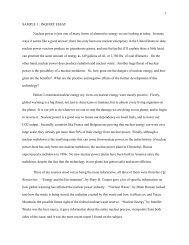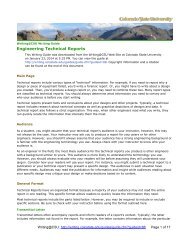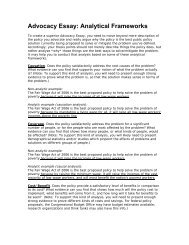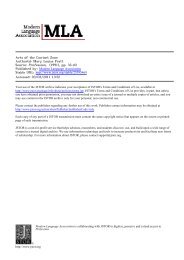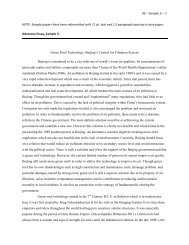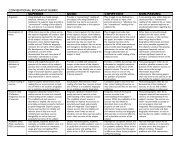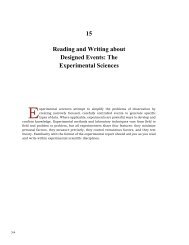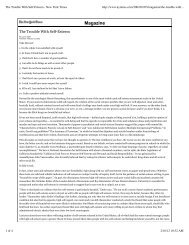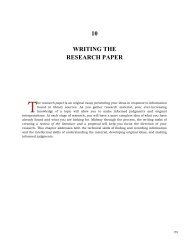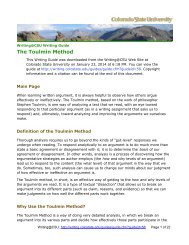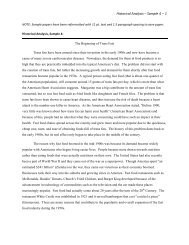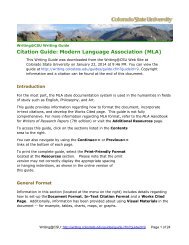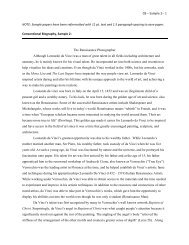Helping Students Use Textual Sources Persuasively Margaret Kantz ...
Helping Students Use Textual Sources Persuasively Margaret Kantz ...
Helping Students Use Textual Sources Persuasively Margaret Kantz ...
Create successful ePaper yourself
Turn your PDF publications into a flip-book with our unique Google optimized e-Paper software.
78 College English<br />
students do not understand that facts are a kind of claim and are often used persuasively<br />
in so-called objective writing to create an impression. <strong>Students</strong> need to<br />
read source texts as arguments and to think about the rhetorical contexts in<br />
which they were written rather than to read them merely as a set of facts to be<br />
learned. Writing an original persuasive argument based on sources requires students<br />
to apply material to a problem or to use it to answer a question, rather<br />
than simply to repeat it or evaluate it. These three problems deserve a separate<br />
discussion.<br />
Because historical texts often have a chronological structure, students believe<br />
that historians tell stories and that renarrating the battle cast them as a historian.<br />
Because her sources emphasized the completeness of the victoryldefeat and its<br />
decisive importance in the history of warfare, Shirley thought that making these<br />
same points in her paper completed her job. Her job as a reader was thus to<br />
learn the story, i.e., so that she could pass a test on it (cf. Vipond and Hunt's<br />
argument that generic expectations affect reading behavior. Vipond and Hunt<br />
would describe Shirley's reading as story-driven rather than point-driven). <strong>Students</strong><br />
commonly misread texts as narratives. When students refer to a textbook<br />
as "the story," they are telling us that they read for plot and character, regardless<br />
of whether their texts are organized as narratives. One reason Shirley<br />
loves history is that when she reads it she can combine her story-reading strategies<br />
with her studying strategies. <strong>Students</strong> like Shirley may need to learn to<br />
apply basic organizing patterns, such as cause-effect and general-to-specific, to<br />
their texts. If, however, Dr. Boyer asks Shirley to respond to her sources in a<br />
way that is not compatible with Shirley's understanding of what such sources<br />
do, Shirley will have trouble doing the assignment. Professors may have to do<br />
some preparatory teaching about why certain kinds of texts have certain characteristics<br />
and what kinds of problems writers must solve as they design text for a<br />
particular audience. They may even have to teach a model for the kind of writing<br />
they expect.<br />
The writing version of Shirley's problem, which Flower calls "writer-based<br />
prose," occurs when Shirley organizes what should be an expository analysis as<br />
a narrative, especially when she writes a narrative about how she did her research.<br />
<strong>Students</strong> frequently use time-based organizing patterns, regardless of the<br />
task, even when such patterns conflict with what they are trying to say and even<br />
when they know how to use more sophisticated strategies. Apparently such<br />
common narrative transitional devices such as "the first point" and "the next<br />
point" offer a reassuringly familiar pattern for organizing unfamiliar material.<br />
The common strategy of beginning paragraphs with such phrases as "my first<br />
source," meaning that it was the first source that the writer found in the library<br />
or the first one read, appears to combine a story-of-my-research structure with a<br />
knowledge-telling strategy (Bereiter and Scardamalia, Psychology). Even when<br />
students understand that the assignment asks for more than the fill-in-the-blanks,<br />
show-me-you've-read-the-material approach described by Schwegler and Shamoon,<br />
they cling to narrative structuring devices. A rank ordering of sources, as<br />
with Mary's analysis of the football game coverage with the sources listed in an



